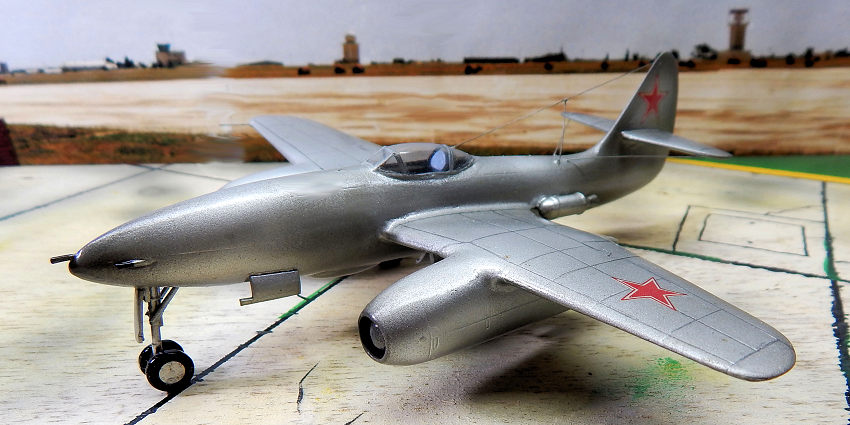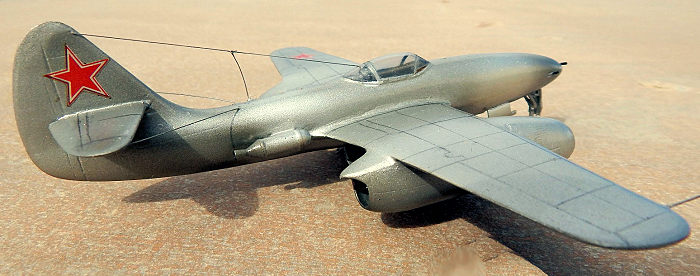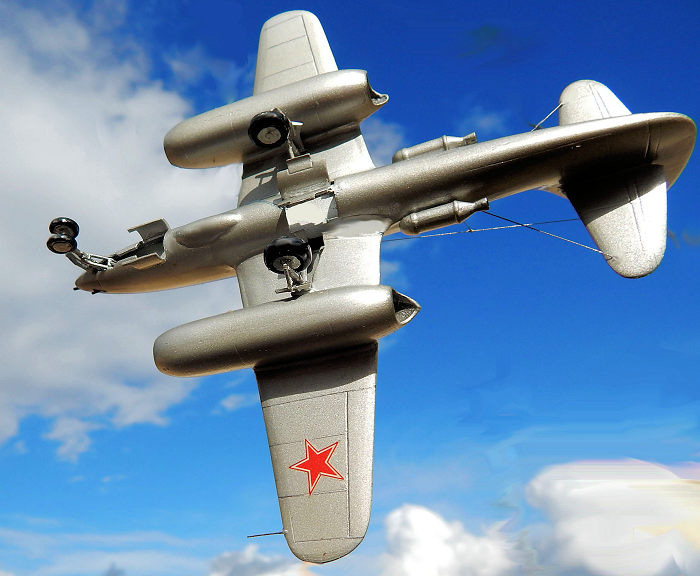
MPM 1/72 Su-9
| KIT #: | 7203 |
| PRICE: | 5 Euros |
| DECALS: | One option |
| REVIEWER: | Carmel J. Attard |
| NOTES: | Vacuform with injected bits. |

| HISTORY |
As early as 1944, work on the design of a jet fighter was already under way by Sukhoi Bureau that was to be powered by two RD-10 (Jumo 004) engines. This aircraft for apparent reasons evolved from the prized German Me 262A Schwalbe and was at the time considered to be introduced into production. The new plane took off on 13th November 1946 being flown by pilot A.G.Kotschetkov. This jet aircraft designated E or Su9 was intended to be a daytime fighter. The bomb load carrying capacity of 500 Kg predetermined the role to be a front fighter-bomber.
 The Sukhoi 9 is an early series
Sukhoi and is not the Su9B Fishpot that was to appear in later years. The Su9
has a close resemblance to the Me 262 and was powered by a Soviet version of the
Jumo 004A. Other differences on the Su9 were that it had an oval section and a
twin wheel nose wheel much unlike the Me 262. It also featured a braking
parachute in the tail. It had very efficient brakes even on the nose double
wheel undercarriage. The Su9 was the first Soviet aircraft with a built in
ejection seat. Two aircraft of the type were built.
The Sukhoi 9 is an early series
Sukhoi and is not the Su9B Fishpot that was to appear in later years. The Su9
has a close resemblance to the Me 262 and was powered by a Soviet version of the
Jumo 004A. Other differences on the Su9 were that it had an oval section and a
twin wheel nose wheel much unlike the Me 262. It also featured a braking
parachute in the tail. It had very efficient brakes even on the nose double
wheel undercarriage. The Su9 was the first Soviet aircraft with a built in
ejection seat. Two aircraft of the type were built.
The Su9 was armed with a 37mm cannon N-37 and two 23mm cannons NS-23. It was possible to mount either a 500Kg bomb or two 250Kg under the fuselage. The aircraft was paraded at the Tushino airfield. The Su-9 was tested with new engines RD-10 in February 1947 with success and a follow up recommendation for the aircraft to series production. 136 flights were made totalling 59 hours. However the production was not implemented owing to lack of financing and poor performance compared to other jets in the pipeline such as the Su-11 and moreover the up-to-date type, the more powerful designated Mig-15 jet completed by Miko designing team.
| THE KIT |
 This is an early MPM model, which
was vac formed in white styrene. Instruction came in form of four pages. One
page contained history in three languages, another had a 1/72 scale three-view
line drawing, another had decals placement and one other page contained an
exploded view easy to follow showing where the vac and injected smaller items
were to be located or joined. Surface detail is represented by engraved lines;
these are quite heavy in scale terms but seemed to be acceptable.
This is an early MPM model, which
was vac formed in white styrene. Instruction came in form of four pages. One
page contained history in three languages, another had a 1/72 scale three-view
line drawing, another had decals placement and one other page contained an
exploded view easy to follow showing where the vac and injected smaller items
were to be located or joined. Surface detail is represented by engraved lines;
these are quite heavy in scale terms but seemed to be acceptable.
The fuselage is split vertically complete with the tail fin and rudder. Several components form the cockpit in certain detail consisting of seat, side consoles, instrument panel, control column, and three semi circular bulkheads mounted one at back of seat and two below the floor. There are RATO rockets, engine front and rear discs, and sparsely detailed undercarriage and wheel doors. Main wing is formed out of five main parts and there is ample of space where to add weight to nose area.
| CONSTRUCTION |
 Assembly of kit is quite straightforward and should not present any problem to
anyone who has tackled a vac form one before and I have used Humbrol liquid
cement right throughout the assembly.
Assembly of kit is quite straightforward and should not present any problem to
anyone who has tackled a vac form one before and I have used Humbrol liquid
cement right throughout the assembly.
Model was sprayed overall silver and given a coat of gloss lacquer. Areas near guns and rockets were diluted with a mix of engine grey and lacquer. I did not fit the belly bomb. With adequate nose weight the model stood firmly on the nose gear. I picked a good set of red stars from my spares box to replace the rather crude form of decals that came with the kit. I enhanced panel lines using pencil lines
| CONCLUSIONS |
General appearance is not dissimilar to that of the Me 262 or the Nakagima Kikka. All three types seem to have something in common and so it is worth adding a Su9 most especially if you have made the other two as they all give a good impression of the shape of early operational jet fighters.
27 November 2017
Copyright ModelingMadness.com
If you would like your product reviewed fairly and fairly quickly, please contact the editor or see other details in the Note to Contributors.
Back to the Main Page Back to the Review Index Page Back to the Previews Index Page